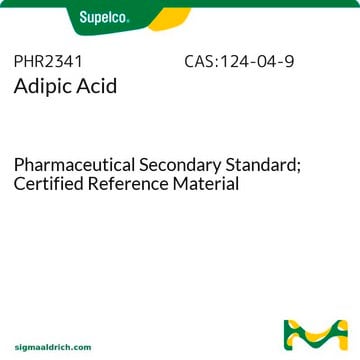Y0000110
Adipic acid
European Pharmacopoeia (EP) Reference Standard
Synonym(s):
Hexanedioic acid
About This Item
Recommended Products
grade
pharmaceutical primary standard
Agency
EP Reference Standard
vapor density
5 (vs air)
vapor pressure
1 mmHg ( 159.5 °C)
API family
adipic acid
autoignition temp.
788 °F
manufacturer/tradename
EDQM
bp
265 °C/100 mmHg (lit.)
mp
151-154 °C (lit.)
application(s)
pharmaceutical (small molecule)
format
neat
storage temp.
2-8°C
SMILES string
OC(=O)CCCCC(O)=O
InChI
1S/C6H10O4/c7-5(8)3-1-2-4-6(9)10/h1-4H2,(H,7,8)(H,9,10)
InChI key
WNLRTRBMVRJNCN-UHFFFAOYSA-N
Looking for similar products? Visit Product Comparison Guide
Related Categories
General description
For further information and support please go to the website of the issuing Pharmacopoeia.
Application
Packaging
Other Notes
related product
Signal Word
Danger
Hazard Statements
Precautionary Statements
Hazard Classifications
Eye Dam. 1
Storage Class Code
11 - Combustible Solids
WGK
WGK 1
Flash Point(F)
384.8 °F - closed cup
Flash Point(C)
196 °C - closed cup
Choose from one of the most recent versions:
Certificates of Analysis (COA)
Sorry, we don't have COAs for this product available online at this time.
If you need assistance, please contact Customer Support.
Already Own This Product?
Find documentation for the products that you have recently purchased in the Document Library.
Our team of scientists has experience in all areas of research including Life Science, Material Science, Chemical Synthesis, Chromatography, Analytical and many others.
Contact Technical Service






